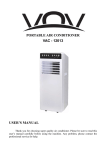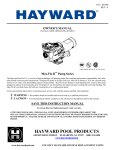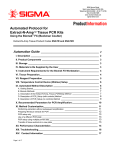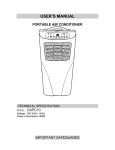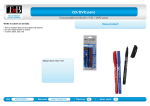Download Mag-Bind® FFPE DNA Kit Mag-Bind® FFPE DNA - Omega Bio-Tek
Transcript
Mag-Bind® FFPE DNA Kit M6957-00 5 preps M6957-01 50 Preps M6957-02 200 Preps Mag-Bind® FFPE DNA 96 Kit M6958-00 1 x 96 preps M6958-01 4 x 96 preps July 2013 Mag-Bind® FFPE DNA Kit Mag-Bind® FFPE DNA 96 Kit Table of Contents Introduction and Overview.......................................................2 Kit Contents.....................................................................................3 Important Notes............................................................................4 Preparing Reagents......................................................................5 Mag-Bind® FFPE DNA Protocol...............................................6 Mag-Bind® FFPE DNA Protocol with Xylene...................10 Mag-Bind® FFPE DNA 96 Protocol.......................................14 Mag-Bind® FFPE DNA 96 Protocol with Xylene.............17 Troubleshooting Guide.............................................................21 Ordering....................................................................................22 Manual Revision: July 2013 Innovations in nucleic acid isolation 1 Introduction and Overview Introduction The Mag-Bind® FFPE DNA and the Mag-Bind® FFPE DNA 96 kits provide a rapid and easy method for the isolation of total DNA from formalin-fixed, paraffin-embedded (FFPE) tissue sections. Due to fixation and embedding procedures, nucleic acids in FFPE samples are heavily fragmented and modified by formaldehyde. While the Mag-Bind® FFPE DNA and the Mag-Bind® FFPE DNA 96 kits are optimized to minimize the effect of the formaldehyde modification, it is not recommended to use the DNA purified with these kits for downstream applications that require full length DNA. Overview The Mag-Bind® FFPE DNA and the Mag-Bind® FFPE DNA 96 kits combine the high efficiency binding properties of Mag-Bind® technology with a specially designed buffer system to isolate total DNA sample from FFPE samples. There are two protocols included in this manual. The standard protocol uses a heating step to remove paraffin from the sample. The alternative protocol uses the traditional xylene extraction to remove paraffin. After the paraffin removal steps, samples are first lysed in FTL Buffer with digestion of Proteinase K. The lysate is then heated to denature the proteinase and mixed with MB3 Buffer and magnetic particles to bind the nucleic acid on the surface of the Mag-Bind® particles. After two wash steps, purified DNA is eluted with Elution Buffer or nuclease-free water. New in this Edition: This manual has been edited for content and redesigned to enhance user readability. • • • 2 Proteinase K is now supplied in a liquid form eliminating the resuspension step to prior to use. Proteinase K Solution can also be stored at room temperature for 12 months. Proteinase Storage Buffer is no longer included in the kit. Kit Contents Mag-Bind® FFPE DNA Kit M6957-00 M6957-01 M6957-02 5 preps 50 preps 200 preps Mag-Bind® Particles CNR 55 µL 550 µL 2.2 mL FTL Buffer 1.5 mL 15 mL 60 mL MB3 Buffer 4.5 mL 45 mL 180 mL MPW Buffer 2 mL 12 mL 45 mL DNA Wash Buffer 2 mL 15 mL 50 mL LPA 55 µL 550 µL 2.2 mL Proteinase K Solution 110 μL 1.1 mL 4 x 1.1 mL Elution Buffer 1.0 mL 10 mL 40 mL User Manual P P P Preparations Mag-Bind® FFPE DNA 96 Kit M6958-00 M6958-01 1 x 96 preps 4 x 96 preps Mag-Bind® Particles CNR 1.1 mL 4.4 mL FTL Buffer 30 mL 110 mL MB3 Buffer 75 mL 250 mL MPW Buffer 30 mL 125 mL DNA Wash Buffer 40 mL 160 mL LPA 1.1 mL 4.4 mL Proteinase K Solution 2.2 mL 9 mL Rnase A 350 µL 1.4 mL Elution Buffer 11 mL 44 mL User Manual P P Preparations 3 Important Notes Storage and Stability All the Mag-Bind® FFPE DNA Kit and the Mag-Bind® FFPE DNA 96 Kit components are guaranteed for at least 12 months from the date of purchase when stored as follows: MagBind® Particles CNR should be stored at 2-8°C. Proteinase K Solution can be stored at room temperature for 12 months. For long-term storage (>12 months), store at 2-8°C. Store all other components at room temperature (22-25°C). Check buffers for precipitates before use. Redissolve any precipitates by warming to 37˚C. Starting Materials Since standard formalin fixation and paraffin-embedding procedures cause significant fragmentation of nucleic acids, we recommend following guidelines to limit the extent of DNA/RNA fragmentation: 1) Use 4-10% formalin to fixate tissue samples; 2) Limit the fixation time to 14-24 hours; 3) Completely dehydrate samples before embedding. Always use freshly cut sections of FFPE tissue for DNA isolation. For the first time user, we recommend to use less than 3-5 sections with thickness of 10 μm. Depending on the yield and purity obtained, it may be possible to increase the starting material. 4 Preparing Reagents Dilute DNA Wash Buffer with 100% ethanol as follows and store at room temperature. Kit 100% Ethanol to be Added M6957-00 8 mL M6957-01 60 mL M6957-02 200 mL Kit 100% Ethanol to be Added M6958-00 160 mL M6958-01 640 mL Dilute MPW Buffer with isopropanol as follows and store at room temperature. Kit Isopropanol to be Added M6957-00 2 mL M6957-01 12 mL M6957-02 45 mL Kit Isopropanol to be Added M6958-00 30 mL M6958-01 125 mL 5 Mag-Bind® FFPE DNA Protocols for M6957 Mag-Bind® FFPE DNA Protocol - 1.5 mL microcentrifuge tube Materials and Equipment to be Supplied by User: • • • • • • • • • Microcentrifuge capable of ≥14,000 x g Magnetic separation device for 1.5 mL microcentrifuge tubes (Cat# MSD-02) Water bath or heat block capable of 55°C Water bath or heat block capable of 80°C Water bath or heat block capable of 90°C Vortexer Nuclease-free 1.5 mL microcentrifuge tubes Isopropanol 100% Ethanol Before Starting: • • • Prepare Buffers according to Preparing Reagents section on Page 5. Set water baths or heat blocks to 90°C, 80°C, and 55°C. Vortex the Mag-Bind® Particles CNR thoroughly before use. 1. Add 250 μL FTL Buffer into a new 1.5 mL microcentrifuge tube. 2. Cut 3-8 paraffin sample sections between 5-10 μm. Note: Do not use the first 2-3 sections from the sample block. 3. Immediately add 2-5 sections to the FTL Buffer. 4. Centrifuge at maximum speed (≥14,000 x g) for 60 seconds. 5. Incubate at 80°C for 15 minutes. Mix the sample a few times by gently shaking the tube 2-3 times. Make sure that the tissue sections stay submerged in the solution. 6. Let sit at room temperature for 5 minutes. 6 Mag-Bind® FFPE DNA Protocols for M6957 7. Add 20 µL Proteinase K Solution. 8. Incubate at 55°C for 3-5 hours with occasional mixing. If necessary, extend the incubation to overnight or until the tissue is completely lysed. 9. Incubate at 90°C for 45-60 minutes. 10. Centrifuge at maximum speed (≥14,000 x g) for 5 minutes. The paraffin will form a thin layer on top of the lysate solution. 11. Transfer 200 μL cleared lysate into a new 1.5 mL microcentrifuge tube. Tip: Use a 1 mL pipette tip or large orifice tip to penetrate the paraffin layer. 12. Add 500 µL MB3 and 10 µL Mag-Bind® Particles CNR. Mix thoroughly by vortexing or pipetting up and down 10-20 times. Note: If DNA content from sample is expected to be low, add 10 µL LPA. 13. Let sit at room temperature for 5-10 minutes. 14. Place the tube on a magnetic separation device to magnetize the Mag-Bind® Particles CNR. Let sit at room temperature until the Mag-Bind® Particles CNR are completely cleared from solution. 15. Aspirate and discard the cleared supernatant. Do not disturb the Mag-Bind® Particles CNR. 16. Remove the tube containing the Mag-Bind® Particles CNR from the magnetic separation device. 7 Mag-Bind® FFPE DNA Protocols for M6957 17. Add 400 µL MPW Wash Buffer. Resuspend the Mag-Bind® Particles CNR by vortexing or pipetting up and down 20 times. Note: MPW Wash Buffer must be diluted with isopropanol prior to use. Please see Page 5 for instructions. 18. Place the tube on a magnetic separation device to magnetize the Mag-Bind® Particles CNR. Let sit at room temperature until the Mag-Bind® Particles CNR are completely cleared from solution. 19. Aspirate and discard the cleared supernatant. Remove any liquid drops from each well. Do not disturb the Mag-Bind® Particles CNR. 20. Remove the tube containing the Mag-Bind® Particles CNR from the magnetic separation device. 21. Add 400 µL DNA Wash Buffer. Resuspend the Mag-Bind® Particles CNR by vortexing or pipetting up and down 20 times. Note: DNA Wash Buffer must be diluted with ethanol prior to use. Please see Page 5 for instructions. 22. Aspirate and discard the cleared supernatant. Do not disturb the Mag-Bind® Particles CNR. 23. Repeat Steps 20-22 for a second DNA Wash step. 24. Leave the tube on the magnetic separation device for 5-10 minutes to air dry the Mag-Bind® Particles CNR. Remove any residual liquid with a pipettor. 25. Remove the tube containing the Mag-Bind® Particles CNR from the magnetic separation device. 26. Add 30-50 µL Elution Buffer. Resuspend the Mag-Bind® Particles CNR by vortexing or pipetting up and down 30 times. 8 Mag-Bind® FFPE DNA Protocols for M6957 27. Incubate at room temperature for 10 minutes. 28. Place the tube on a magnetic separation device to magnetize the Mag-Bind® Particles CNR. Let sit at room temperature until the Mag-Bind® Particles CNR are completely cleared from solution. 29. Transfer the cleared supernatant containing purified DNA to a clean 1.5 mL microcentrifuge tube. Store the DNA at -20°C. 9 Mag-Bind® FFPE DNA Protocols for M6957 Mag-Bind® FFPE DNA - 1.5 mL microcentrifuge tube with xylene Note: The following protocol uses xylene to remove paraffin from the FFPE sample. Use fume hood and take proper protection during xylene extraction. Materials and Equipment to be Supplied by User: • • • • • • • • • • Microcentrifuge capable of ≥14,000 x g Magnetic separation device for 1.5 mL microcentrifuge tubes (Cat# MSD-02) Water bath or heat block capable of 55°C Water bath or heat block capable of 80°C Water bath or heat block capable of 90°C Vortexer Nuclease-free 1.5 mL microcentrifuge tubes Isopropanol 100% Ethanol Xylene Things to do before starting: • • • Prepare Buffers according to Preparing Reagents section on Page 5. Set water baths or heat blocks to 90°C, 80°C, and 55°C. Vortex the Mag-Bind® Particles CNR thoroughly before use. 1. Add 1 mL xylene into a new 1.5 mL microcentrifuge tube. 2. Cut 3-8 paraffin sample sections between 5-10 μm. Note: Do not use the first 2-3 sections from the sample block. 3. Immediately add 2-5 sections to the xylene. Vortex for 20 seconds to mix thoroughly. 4. Centrifuge at maximum speed (≥14,000 x g) for 5-10 minutes to pellet the tissue. Note: If the tissue does not form a tight pellet, centrifuge for an additional 3 minutes. 10 Mag-Bind® FFPE DNA Protocols for M6957 5. Aspirate and discard the xylene. Do not disturb the tissue pellet. 6. Add 1 mL 100% ethanol. Vortex for 20 seconds to mix thoroughly. 7. Centrifuge at maximum speed (≥14,000 x g) for 5 minutes to pellet the tissue. The pellet should appear opaque. 8. Aspirate and discard the ethanol. Do not disturb the tissue pellet. Remove any liquid drops with a pipette. 9. Repeat Steps 6-8 for a second ethanol wash step. 10. Let sit at room temperature for 10-20 minutes. Note: It is critical to completely dry the sample before the next Proteinase K digestion step. Residual ethanol will affect the efficiency of the Proteinase K digestion. If a vacuum oven is available, place the tube in the vacuum oven preset at 45°C for 10-20 minutes. 11. Add 250 μL FTL Buffer and 20 μL Proteinase K Solution. Resuspend the pellet by vortexing or pipetting up and down 20 times. 12. Incubate at 55°C for 3-5 hours with occasional mixing. If necessary, extend the incubation to overnight or until the tissue is completely lysed. 13. Incubate at 90°C for 45-60 minutes. 14. Centrifuge at maximum speed (≥14,000 x g) for 5 minutes. 15. Transfer 200 µL cleared supernatant into a new 1.5 mL microcentrifuge tube. 11 Mag-Bind® FFPE DNA Protocols for M6957 16. Add 500 µL MB3 Buffer and 10 µL Mag-Bind® Particles CNR. Mix thoroughly by vortexing or pipetting up and down 10-20 times. Note: If DNA content from sample is expected to be low, add 10 µL LPA. 17. Let sit at room temperature for 5-10 minutes. 18. Place the tube on a magnetic separation device to magnetize the Mag-Bind® Particles CNR. Let sit at room temperature until the Mag-Bind® Particles CNR are completely cleared from solution. 19. Aspirate and discard the cleared supernatant. Do not disturb the Mag-Bind® Particles CNR. 20. Remove the tube containing the Mag-Bind® Particles CNR from the magnetic separation device. 21. Add 400 µL MPW Wash Buffer. Resuspend the Mag-Bind® Particles CNR by vortexing or pipetting up and down 20 times. Note: MPW Wash Buffer must be diluted with isopropanol prior to use. Please see Page 5 for instructions. 22. Place the tube on a magnetic separation device to magnetize the Mag-Bind® Particles CNR. Let sit at room temperature until the Mag-Bind® Particles CNR are completely cleared from solution. 23. Aspirate and discard the cleared supernatant. Remove any liquid drops from each well. Do not disturb the Mag-Bind® Particles CNR. 24. Remove the tube containing the Mag-Bind® Particles CNR from the magnetic separation device. 12 Mag-Bind® FFPE DNA Protocols for M6957 25. Add 400 µL DNA Wash Buffer. Resuspend the Mag-Bind® Particles CNR by vortexing or pipetting up and down 20 times. Note: DNA Wash Buffer must be diluted with ethanol prior to use. Please see Page 5 for instructions. 26. Aspirate and discard the cleared supernatant. Do not disturb the Mag-Bind® Particles CNR. 27. Repeat Steps 24-26 for a second DNA Wash step. 28. Leave the tube on the magnetic separation device for 5-10 minutes to air dry the Mag-Bind® Particles CNR. Remove any residual liquid with a pipettor. 29. Remove the tube containing the Mag-Bind® Particles CNR from the magnetic separation device. 30. Add 30-50 µL Elution Buffer. Resuspend the Mag-Bind® Particles CNR by vortexing or pipetting up and down 30 times. 31. Incubate at room temperature for 10 minutes. 32. Place the tube on a magnetic separation device to magnetize the Mag-Bind® Particles CNR. Let sit at room temperature until the Mag-Bind® Particles CNR are completely cleared from solution. 33. Transfer the cleared supernatant containing purified DNA to a clean 1.5 mL microcentrifuge tube. Store the DNA at -20°C. 13 Mag-Bind® FFPE DNA Protocols for M6958 Mag-Bind® FFPE DNA 96 - 96-well plate Materials and Equipment to be Supplied by User: • • • • • • • • • • • • Centrifuge with swing-bucket rotor capable of 4,000 x g Rotor adaptor for 96-well deep-well plates Magnetic separation device for 96-well deep-well plates (Cat# MSD-01B) Water bath or heat block capable of 55°C Water bath or heat block capable of 80°C Water bath or heat block capable of 90°C Vortexer 1.2 mL or 2.0 mL round-well plates Nuclease-free 96-well microplates Isopropanol 100% Ethanol Sealing film Things to do before starting: • • • Prepare Buffers according to Preparing Reagents section on Page 5. Set water baths or heat blocks to 90°C, 80°C, and 55°C. Vortex the Mag-Bind® Particles CNR thoroughly before use. 1. Add 250 μL FTL Buffer into each well of a 1.2 mL or 2.0 mL round-well plate. 2. Cut 3-8 paraffin sample sections between 5-10 μm. Note: Do not use the first 2-3 sections from the sample block. 3. Immediately add 2-5 sections to the FTL Buffer. 4. Centrifuge at 4,000 x g for 5 minutes at room temperature. 5. Incubate at 80°C for 15 minutes. Mix the sample a few times by gently shaking the plate 2-3 times. Make sure that the tissue sections stay submerged in the solution. Note: Seal the plate with sealing film to prevent evaporation during incubation. 14 Mag-Bind® FFPE DNA Protocols for M6958 6. Let sit at room temperature for 5 minutes. 7. Add 20 µL Proteinase K Solution. 8. Incubate at 55°C for 3-5 hours with occasional mixing. If necessary, extend the incubation to overnight or until the tissue is completely lysed. 9. Incubate at 90°C for 45-60 minutes. 10. Centrifuge at 4,000 x g for 5 minutes. The paraffin will form a thin layer on top of the lysate solution. 11. Transfer 200 μL cleared lysate into a new 96-well round-well plate. Tip: Use a 1 mL pipette tip or large orifice tip to penetrate the paraffin layer. 12. Add 500 µL MB3 Buffer and 10 µL Mag-Bind® Particles CNR. Mix thoroughly by vortexing or pipetting up and down 10-20 times. Note: If DNA content from sample is expected to be low, add 10 µL LPA. 13. Let sit at room temperature for 5-10 minutes. 14. Place the plate on the magnetic separation device to magnetize the Mag-Bind® Particles CNR. Let sit at room temperature until the Mag-Bind® Particles CNR are completely cleared from solution. 15. Aspirate and discard the supernatant. Do not disturb the Mag-Bind® Particles CNR. 16. Remove the plate from the magnetic separation device. 17. Add 400 µL MPW Wash Buffer. Resuspend the Mag-Bind® Particles CNR by vortexing or pipetting up and down 20 times. Note: MPW Wash Buffer must be diluted with isopropanol prior to use. Please see Page 5 for instructions. 15 Mag-Bind® FFPE DNA Protocols for M6958 18. Place the plate on the magnetic separation device to magnetize the Mag-Bind® Particles CNR. Let sit at room temperature until the Mag-Bind® Particles CNR are completely cleared from solution. 19. Aspirate and discard the supernatant. Do not disturb the Mag-Bind® Particles CNR. 20. Remove the plate from the magnetic separation device. 21. Add 400 µL DNA Wash Buffer. Resuspend the Mag-Bind® Particles CNR by vortexing or pipetting up and down 20 times. Note: DNA Wash Buffer must be diluted with ethanol prior to use. Please see Page 5 for instructions. 22. Aspirate and discard the cleared supernatant. Do not disturb the Mag-Bind® Particles CNR. 23. Repeat Steps 20-22 for a second DNA Wash step. 24. Leave the plate on the magnetic separation device for 5-10 minutes to air dry the Mag-Bind® Particles CNR. Remove any residual liquid with a pipettor. 25. Add 30-50 µL Elution Buffer. Resuspend the Mag-Bind® Particles CNR by vortexing or pipetting up and down 30 times. 26. Incubate at room temperature for 10 minutes. 27. Place the plate on a magnetic separation device to magnetize the Mag-Bind® Particles CNR. Let sit at room temperature until the Mag-Bind® Particles CNR are completely cleared from solution. 28. Transfer the cleared supernatant containing purified DNA to a nuclease-free 96-well microplate. Store the DNA at -20°C. 16 Mag-Bind® FFPE DNA Protocols for M6958 Mag-Bind® FFPE DNA 96 - 96-well plate with xylene Note: The following protocol uses xylene to remove paraffin from the FFPE sample. Use fume hood and take proper protection during xylene extraction. Materials and Equipment to be Supplied by User: • • • • • • • • • • • • • Centrifuge with swing-bucket rotor capable of 4,000 x g Rotor adaptor for 96-well deep-well plates Magnetic separation device for 96-well deep-well plates (Cat# MSD-01B) Water bath or heat block capable of 55°C Water bath or heat block capable of 80°C Water bath or heat block capable of 90°C Vortexer 1.2 mL or 2.0 mL round-well plates Nuclease-free 96-well microplates Isopropanol 100% Ethanol Xylene Sealing film Things to do before starting: • • • Prepare Buffers according to Preparing Reagents section on Page 5. Set water baths or heat blocks to 90°C, 80°C, and 55°C. Vortex the Mag-Bind® Particles CNR thoroughly before use. 1. Add 1 mL xylene into each well of a 1.2 mL or 2.0 mL round-well plate. 2. Cut 3-8 paraffin sample sections between 5-10 μm. Note: Do not use the first 2-3 sections from the sample block. 3. Immediately add 2-5 sections to the xylene. Vortex for 20 seconds to mix thoroughly. 4. Centrifuge at 4,000 x g for 5-10 minutes to pellet the tissue. Note: If the tissue does not form a tight pellet, centrifuge for an additional 5 minutes. 17 Mag-Bind® FFPE DNA Protocols for M6958 5. Aspirate and discard the xylene. Do not disturb the tissue pellet. 6. Add 1 mL 100% ethanol. Vortex for 20 seconds to mix thoroughly. 7. Centrifuge at 4,000 x g for 5 minutes to pellet the tissue. The pellet should appear opaque. 8. Aspirate and discard the ethanol. Do not disturb the tissue pellet. Remove any liquid drops with a pipette. 9. Repeat Steps 6-8 for a second ethanol wash step. 10. Let sit at room temperature for 10-20 minutes. Note: It is critical to completely dry the sample before the next Proteinase K digestion step. Residual ethanol will affect the efficiency of the Proteinase K digestion. If a vacuum oven is available, place the tube in the vacuum oven preset at 45°C for 10-20 minutes. 11. Add 250 μL FTL Buffer and 20 μL Proteinase K Solution. Resuspend the pellet by vortexing or pipetting up and down 20 times. 12. Incubate at 55°C for 3-5 hours with occasional mixing. If necessary, extend the incubation to overnight or until the tissue is completely lysed. 13. Incubate at 90°C for 45-60 minutes. 14. Centrifuge at 4,000 x g for 5 minutes. 15. Transfer 200 µL cleared supernatant into a new 1.2 mL or 2.0 mL round-well plate. 18 Mag-Bind® FFPE DNA Protocols for M6958 16. Add 500 µL MB3 Buffer and 10 µL Mag-Bind® Particles CNR. Mix thoroughly by vortexing or pipetting up and down 10-20 times. Note: If DNA content from sample is expected to be low, add 10 µL LPA. 17. Let sit at room temperature for 5-10 minutes. 18. Place the plate on the magnetic separation device to magnetize the Mag-Bind® Particles CNR. Let sit at room temperature until the Mag-Bind® Particles CNR are completely cleared from solution. 19. Aspirate and discard the supernatant. Do not disturb the Mag-Bind® Particles CNR. 20. Remove the plate from the magnetic separation device. 21. Add 400 µL MPW Wash Buffer. Resuspend the Mag-Bind® Particles CNR by vortexing or pipetting up and down 20 times. Note: MPW Wash Buffer must be diluted with isopropanol prior to use. Please see Page 5 for instructions. 22. Place the plate on the magnetic separation device to magnetize the Mag-Bind® Particles CNR. Let sit at room temperature until the Mag-Bind® Particles CNR are completely cleared from solution. 23. Aspirate and discard the supernatant. Do not disturb the Mag-Bind® Particles CNR. 24. Remove the plate from the magnetic separation device. 25. Add 400 µL DNA Wash Buffer. Resuspend the Mag-Bind® Particles CNR by vortexing or pipetting up and down 20 times. Note: DNA Wash Buffer must be diluted with ethanol prior to use. Please see Page 5 for instructions. 19 Mag-Bind® FFPE DNA Protocols for M6958 26. Aspirate and discard the cleared supernatant. Do not disturb the Mag-Bind® Particles CNR. 27. Repeat Steps 24-26 for a second DNA Wash step. 28. Leave the plate on the magnetic separation device for 5-10 minutes to air dry the Mag-Bind® Particles CNR. Remove any residual liquid with a pipettor. 29. Add 30-50 µL Elution Buffer. Resuspend the Mag-Bind® Particles CNR by vortexing or pipetting up and down 30 times. 30. Incubate at room temperature for 10 minutes. 31. Place the plate on a magnetic separation device to magnetize the Mag-Bind® Particles CNR. Let sit at room temperature until the Mag-Bind® Particles CNR are completely cleared from solution. 32. Transfer the cleared supernatant containing purified DNA to a nuclease-free 96-well microplate. Store the DNA at -20°C. 20 Troubleshooting Guide Please use this guide to troubleshoot any problems that may arise. For further assistance, please contact the technical support staff, toll free, at 1-800-832-8896. Problem Low DNA yields Problem Cause Solution Incomplete resuspension of magnetic particles Resuspend the magnetic particles by vortexing before use. DNA degraded during sample storage Make sure the sample is properly stored and make sure the samples are processed immediately after collection or removal from storage. MPW Buffer and DNA Wash Prepare MPW Buffer and DNA Wash Buffer Buffer were not prepared according to the instructions on Page 5. correctly Loss of magnetic beads during operation Increase the bead collection time. Cause Solution Problem with DNA is over fixated during downstream tissue formalin fixation application Extend incubation time at 90°C to 90 minutes. Carryover of the magnetic beads in the elution To remove the carryover magnetic particles from the eluted DNA, simply magnetize the magnetic particles and carefully transfer the DNA eluate to a new plate. Carryover the magnetic beads in the eluted DNA will not effect downstream applications 21 Ordering Information The following components are available for purchase separately. (Call Toll Free at 1-800-832-8896) Product E-Z 96® Magnetic Separation Device, Radial Magnetizing Part Number MSD-01B 96-well Round-well Plate (1.2 mL), 10/pk SSI-1780-00 96-well Round-well Plate (1.2 mL), 100/cs SSI-1780-01 Multi-Channel Disposable Reservoirs, 100/pk AC1331-01 SealPlate Film, 100/box AC1200-01 96-well Microplate (300 μL), 5/pk EZ9603-01 96-well Microplate (300 μL), 25/pk EZ9603-02 96-well Microplate (500 μL), 5/pk EZ9604-01 96-well Microplate (500 μL), 25/pk EZ9604-02 DNA Wash Buffer, 40 mL PS001 DNA Wash Buffer, 100 mL PDR044 DNA Wash Buffer, 500 mL PS011 Elution Buffer, 100 mL PDR048 HiBind®, E.Z.N.A.®, and MicroElute® are registered trademarks of Omega Bio-tek, Inc. Qiagen®, QIAvac® and Vacman® are all trademarks of their respective companies. PCR is a patented process of Hoffman-La Roche. Use of the PCR process requires a license. 22 Notes: 23 Notes: 24

































